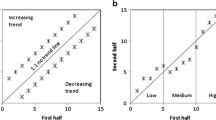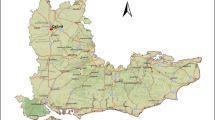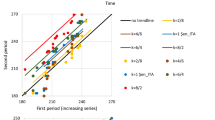Abstract
This paper attempts to determine and visualize the trends by considering the value via Şen’s innovative trend analysis methodology, which has been suggested instead of the well-known approaches called Mann-Kendall (MK), Spearman’s rho (SR), Sen’s slope, and linear regression methodologies. Another attempt is to show that an additional trend approach by using half time series methodology (HTSM) including MK’s Z value, and to compare it with the innovative method. Although, Şen’s method is practical, easy and clear representation of data variation, but some information is not evident on time series. This study comprises 66-year rain gage records in Adana, İzmir, and Rize stations located in different regions of Turkey. The comparison results indicated different trend conditions for these stations. Based on this information, representative figures are obtained according to Şen’s and HTSM for the precipitation records. According to Şen’s method, Adana and Rize stations’ measurements have no trend component but İzmir data have monotonically increasing trend. HTSM results reveal some additional information on Şen’s half time series approach. Adana station time series halves include opposite trends (increasing-decreasing) detected by HTSM in spite of no trend. Different extreme cases are encountered in İzmir and Rize stations through HTSM. As a result, if the proposed method is combined with Şen’s method, better trend analysis results can be obtained for detailed interpretations.










Similar content being viewed by others
References
Alashan S (2018) An improved version of innovative trend analyses. Arab J Geosci 11(3):50
Belihu M, Abate B, Tekleab S, Bewket W (2017) Hydro-meteorological trends in the Gidabo catchment of the Rift Valley Lakes Basin of Ethiopia. Phys Chem Earth. https://doi.org/10.1016/j.pce.2017.10.002
Bezak N, Brilly M, Šraj M (2014) Flood frequency analyses, statistical trends and seasonality analyses of discharge data: a case study of the Litija station on the Sava River. J Flood Risk Manag. https://doi.org/10.1111/jfr3.12118
Biswas S (2003) Groundwater direction and longterm trend of water level of Nadia district, West Bengal; a statistical analysis. J Geol Soc India 61:22–36
Cheo AE (2016) Understanding seasonal trend of rainfall for the better planning of water harvesting facilities in the Far-North region, Cameroon. Water Utility J 13:3–11
Cui L, Wang L, Lai Z, Tian Q, Liu W, Li J (2017) Innovative trend analysis of annual and seasonal air temperature and rainfall in the Yangtze River Basin, China during 1960–2015. J Atmos Sol Terr Phys 164:48–59
Güçlü YS (2016) Comments on “Comparison of Mann–Kendall and innovative trend method for water quality parameters of the Kizilirmak River, Turkey (Kisi and Ay, 2014)” and “An innovative method for trend analysis of monthly pan evaporations (Kisi, 2015)”. J Hydrol 538:878–882
Güçlü YS, Şişman E, Yeleğen MÖ (2018) Climate change and frequency–intensity–duration (FID) curves for Florya station, Istanbul. J Flood Risk Manag 11(S1):S403–S418
Haan CT (1977) Statistical methods in hydrology. The Iowa State University Press, Ames
Hamed KH, Rao AR (1998) A modified Mann-Kendall trend test for autocorrelated data. J Hydrol 204:182–196
Helsel DR, Hirsch RM (2002) Statistical methods in water resources, Chapter A3, Techniques of water resources investigations, Book 4, U.S. Geological Survey, Shenandoah
Jonsdottir JF, Uvo CB, Clarke RT (2008) Trend analysis in Icelandic discharge, temperature and precipitation series by parametric methods. Hydrol Res 39(5–6):425–436
Kendall MG (1975) Rank correlation methods. Charless Griffin, London
Kim JS, Jain S (2010) High-resolution streamflow trend analysis applicable to annual decision calendars: a western United States case study. Clim Chang 102(3–4):699–707
Lehmann EL (1975) Nonparametrics, statistical methods based on ranks. Holden-Day Inc, California
Mann HB (1945) Nonparametric tests against trend. Econometrica 13:245–259
Mishra A, Coulibaly P (2014) Variability in Canadian seasonal streamflow information and its implication for hydrometric network design. J Hydrol Eng. https://doi.org/10.1061/(ASCE)HE.1943-5584.0000971
Öztopal A, Şen Z (2016) Innovative trend methodology applications to precipitation records in Turkey. Water Resour Manag. https://doi.org/10.1007/s11269-016-1343-5
Pakalidou N, Karacosta P (2017) Study of very long-period extreme precipitation records in Thessaloniki, Greece. Atmos Res. https://doi.org/10.1016/j.atmosres.2017.07.029
Sen PK (1968) Estimates of the regression coefficient based on Kendall’s tau. J Am Stat Assoc 63:1379–1389
Şen Z (2012) Innovative trend analysis methodology. J Hydrol Eng 17(9):1042–1046
Şen Z (2015) Innovative trend significance test and applications. Theor Appl Climatol. https://doi.org/10.1007/s00704-015-1681-x
Şen Z (2017) Innovative trend methodologies in science and engineering. Springer, Heidelberg
Shadmani M, Marofi S, Roknian M (2012) Trend analysis in reference evapotranspiration using Mann-Kendall and Spearman’s Rho tests in Arid Regions of Iran. Water Resour Manag 26(1):211–224
Shi J, Cui L, Wen K, Tian Z, Wei P, Zhang B (2018) Trends in the consecutive days of temperature and precipitation extremes in China during 1961–2015. Environ Res 161:381–391
Sneyers R (1990) On the statistical analysis of series of observations. World Meteorological Organization Technical Note no. 143 WMO no. 415
Sonali P, Kumar ND (2013) Review of trend detection methods and their application to detect temperature changes in India. J Hydrol 476:212–227
Tabari H, Marofi S, Aeini A, Talaee PH, Mohammadi K (2011) Trend analysis of reference evapotranspiration in the western half of Iran. Agric For Meteorol 151(2):128–136
Timbadiya P, Mirajkar A, Patel P, Porey P (2013) Identification of trend and probability distribution for time series of annual peak flow in Tapi Basin, India. ISH Int J Hydraulic Eng 19(1):11–20
Author information
Authors and Affiliations
Corresponding author
About this article
Cite this article
Güçlü, Y.S. Alternative Trend Analysis: Half Time Series Methodology. Water Resour Manage 32, 2489–2504 (2018). https://doi.org/10.1007/s11269-018-1942-4
Received:
Accepted:
Published:
Issue Date:
DOI: https://doi.org/10.1007/s11269-018-1942-4




